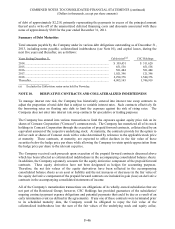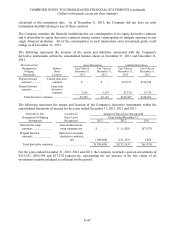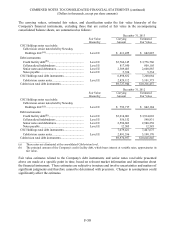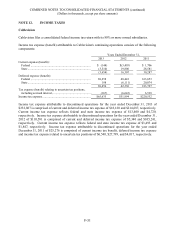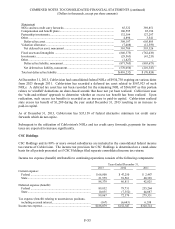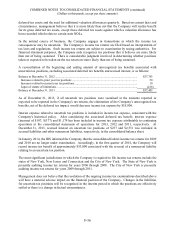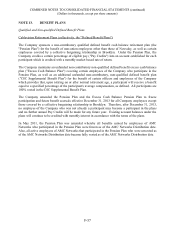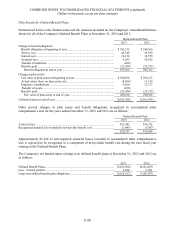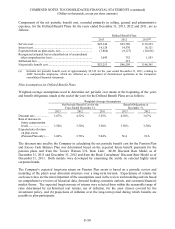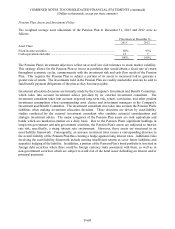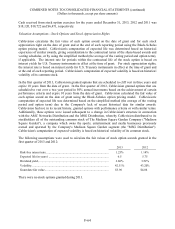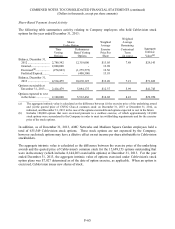Cablevision 2013 Annual Report Download - page 164
Download and view the complete annual report
Please find page 164 of the 2013 Cablevision annual report below. You can navigate through the pages in the report by either clicking on the pages listed below, or by using the keyword search tool below to find specific information within the annual report.
COMBINED NOTES TO CONSOLIDATED FINANCIAL STATEMENTS (continued)
(Dollars in thousands, except per share amounts)
F-55
For CSC Holdings, the tax effects of temporary differences which give rise to significant portions of
deferred tax assets or liabilities and the corresponding valuation allowance at December 31, 2013 and
2012 are as follows:
December 31,
2013
2012
Deferred Tax Asset (Liability)
Current
Tax credit carry forwards ................................................................................
$ -
$ 24,573
Compensation and benefit plans ......................................................................
44,629
37,556
Allowance for doubtful accounts .....................................................................
5,502
4,807
Other liabilities ...............................................................................................
13,389
11,958
Deferred tax asset ........................................................................................
63,520
78,894
Valuation allowance........................................................................................
(2,426)
(2,443)
Net deferred tax asset, current ......................................................................
61,094
76,451
Investments.....................................................................................................
(97,565)
(63,950)
Prepaid expenses .............................................................................................
(24,111)
(17,061)
Deferred tax liability, current .......................................................................
(121,676)
(81,011)
Net deferred tax liability, current..................................................................
(60,582)
(4,560)
Noncurrent
Tax credit carry forwards ................................................................................
20,137
19,834
Compensation and benefit plans ......................................................................
106,595
85,196
Partnership investments...................................................................................
132,384
127,297
Other ..............................................................................................................
4,896
3,546
Deferred tax asset ........................................................................................
264,012
235,873
Valuation allowance........................................................................................
(10,084)
(9,868)
Net deferred tax asset, noncurrent ................................................................
253,928
226,005
Fixed assets and intangibles ............................................................................
(840,375)
(762,438)
Investments.....................................................................................................
(29,563)
(41,235)
Other ..............................................................................................................
(1,827)
-
Deferred tax liability, noncurrent .................................................................
(871,765)
(803,673)
Net deferred tax liability, noncurrent ............................................................
(617,837)
(577,668)
Total net deferred tax liability .........................................................................
$(678,419)
$(582,228)
At December 31, 2013, on a stand-alone basis CSC Holdings had fully utilized all NOLs for which a
deferred tax asset had been recorded and all NOLs relating to 'windfall' deductions on share-based
awards. CSC Holdings uses the 'with-and-without' approach to determine whether an excess tax benefit
has been realized. Upon realization, the excess tax benefits for these 'windfall' deductions is recorded as
an increase to member's equity. On a stand-alone basis CSC Holdings realized federal and state excess
tax benefit of $46,164 during the year ended December 31, 2013. Such excess tax benefit resulted in an
increase to member's equity.
The Company
Deferred tax assets have resulted primarily from the Company's future deductible temporary differences
and NOLs. In assessing the realizability of deferred tax assets, management considers whether it is more
likely than not that some portion or all of the deferred tax asset will not be realized. The Company's
ability to realize its deferred tax assets depends upon the generation of sufficient future taxable income
and tax planning strategies to allow for the utilization of its NOLs and deductible temporary differences.
If such estimates and related assumptions change in the future, the Company may be required to record
additional valuation allowances against its deferred tax assets, resulting in additional income tax expense
in the Company's consolidated statements of income. Management evaluates the realizability of the



